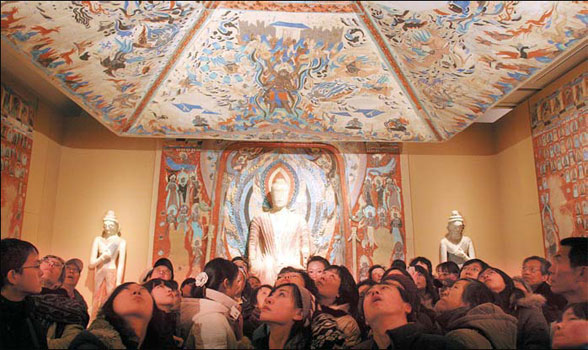Visitors to the National Art Museum of China are surprised to discover the museum's facade now resembles the world-renowned Dunhuang Mogao Grottoes, in Gansu province.
A colorful, wooden archway has been sited in the piazza, in front of the museum, attracting passers-by with its elegant architecture and three huge, gilded Chinese characters-mo gao ku (Mogao Grottoes), popularly known as the Caves of the Thousand Buddhas.
Two clay-sculpted guardians in ancient armor stand at the entrance, introducing visitors to a series of labyrinths, or "caves with mural art."
Lights of Dunhuang, a grand exhibition of mural art and ancient relics from the largest Chinese Buddhist art trove in the world is being held at the museum.
The highlights of the show are 10 duplicate ancient caves, 120 mural copies, created by generations of Chinese researchers/artists, nine authentic clay figurines and wooden sculptures, and 10 ancient manuscripts.
These are priceless treasures under State protection, organizers say.
Over half a century, about 60 exhibitions of Dunhuang's mural art have toured cities in and outside China but "this one is by far the largest and most comprehensive," says Fan Jinshi, president of the 64-year-old Dunhuang Academy, that researches, conserves and promotes the 1,600-year-old cave art.
"As part of the Olympics program, the exhibition offers visitors from around the world a rare chance to experience the best of classic Chinese art in the dynamic, modern metropolis of Beijing," she says.
Left: Lights of Dunhuang, an exhibition of mural art and ancient relics from Dunhuang Mogao Grottoes, is being held at the National Art Museum of China. Right: A grand-sized mural painting featuring flying fairies. Photos by Jiang Dong
The exhibition is the first large-scale, arts and culture event in Beijing so far this year. Since Jan 19, the museum has received over 7,000 visitors a day, local media has reported.
"The art from Dunhuang Mogao Grottoes is at the root of classic Chinese art," Chang Shana, a veteran artist and former dean of School of Arts, Tsinghua University, says.
"An in-depth understanding of how traditional art evolves can help artists striving to find their own voices in the 21st century."
Bo Songnian, an art historian who has visited the Mogao Grottoes many times, attended the exhibition, along with a couple of his students at the Central Academy of Fine Arts.
"Although the cave art on show are mostly quality duplicates, they still are worth a close look. In the caves you may not be able to see the details of the murals and relics so clearly," Bo says.
"For years, I have dreamt of visiting Dunhuang, for the great mural art. But my physical condition has prevented me," says Wei Jinlong, a retired Beijinger who came with his granddaughter to the exhibition.
Hu Lihai, a graphic designer, attended the show to find inspiration for his daily work.
"I am totally enthralled by the ancient art from the Mogao Grottoes. I plan to visit the caves after Spring Festival," Hu says.
Beginning later this year, visitors will be required to register to see the caves. Just 2,000 visitors will be able to view the 50 caves a day, although a total of 812 caves with mural art and other ancient relics are extant.
The idea behind this move is to preserve the antiquities, according to Fan Jingshi, who adds "promoting Dunhuang art is our responsibility but keeping the mural art intact is our top priority."
At the exhibition that continues until March 21, around 75 trained guides will provide services for visitors in English, Korean, German, French, Japanese and Chinese. Also, researchers from Dunhuang and Beijing will deliver lectures on ancient Chinese mural art and history at the conference hall, on the seventh floor of the museum.
Interactive touch screens and videos about art and relics from the Dunhuang Mogao Grottoes will also be made available.
The largest, most comprehensive and best-preserved collection of Buddhist mural art in China and the world, the Mogao Grottoes have been widely recognized as a repository of information about life and society in ancient China and along the Silk Road.
The rediscovered Library Cave with its 50,000 ancient documents and manuscripts have offered scholars an unrivaled wealth of source material for studying the ancient art, cultures and history.
Nestled in the Gobi Desert in Northwest China, Dunhuang was the last oasis on the ancient Silk Road of China, for travelers from the 4th to 15th century.
Due to its isolated location, Dunhuang survived two eras of Buddhists persecution, but in the early 20th century foreign archeologists removed a great number of Dunhuang relics and treasures, now scattered over 30 museums around the world, according to Yang Xiuqing, veteran scholar and deputy editor-in-chief of Dunhuang Studies magazine.
"Dunhuang has been an endless fountain of inspiration for generations of Chinese artists," says museum director Fan Di'an, who has also prepared two minor exhibitions accompanying the grand Lights of Dunhuang cave art show.
On display are copies of the Dunhuang mural paintings by such painters as Zhang Daqian, Dong Xiwen, Wu Zuoren, Guan Shanyue, Ye Qianyu, and Yuan Yunfu.
Also on show are ink and oil works by younger artists from the Research Institute of Fine Arts in Mogao Grottoes such as Hou Liming, and Chen Haitao.
Visitors at a duplicate cave of the Dunhuang Grottoes, featuring murals on the ceiling and walls.
(China Daily January 24, 2008)




